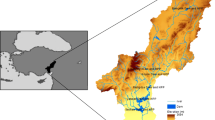Abstract
Water balance under different management scenarios was tested in Deduru Oya reservoir project system, Sri Lanka with focus on Left Bank canal system to address agricultural, energy, and environmental water deficits in all seasons. A conceptual rainfall-runoff model, SimHyd, was employed for modeling discharge into ancient tanks. CropWat model enabled estimation of irrigation water requirement for rice crops, the main agricultural water demand. Water Evaluation And Planning (WEAP) model was applied for testing deficits between water supply and demand systems. Graphs of coverage and unmet water demands pointed out that most of the tanks are not able to meet two-season irrigation water requirements. Water shortages occurred in the months of March, May, June, and September. In dry climatic year, tanks and reservoir storages together may not be well enough to meet September water demands if operated conventionally (i.e., farmers are free to use tank water as they want). Results of water allocation modeling pointed out that there will be no water shortages if farmers are convinced to retain water of about 40% of tank inflows for the use in September.







Similar content being viewed by others
References
Allen RG, Pereira LS ,Raes D, Smith M (1998) Crop evapotranspiration—Guidelines for computing crop water requirements. FAO Irrigation and Drainage Paper, No. 56. FAO, Rome
Amarasinghe UA, Mutuwatta L, Sakthicadivel R (1999) Water scarcity variations within a country: a case study of Sri Lanka, Technical Report 32, International Water Management Institute, Colombo, Sri Lanka
Arnold, T. 2006. Crop yield under water deficit: The CropWat Module in MP-MAS/EDIC.
Batjes, N.H. 2008. ISRIC-WISE Harmonic Global Soil profile dataset (version 3.1), Report 2008/02, ISRIC-World Soil Information.
Chiew FHS, Siriwardena L.2005. Estimation of SimHyd parameter values for application in ungauged catchments (http://www.mssanz.org.au/modsim05/papers/chiew_2.pdf).
De Silva CS, Weatherhead EK, Knox JW, Rodriguez-Diaz JA (2007) Predicting the Impacts of Climate Change-A Case Study of Paddy Irrigation Water requirements in Sri Lanka. J Agric Water Manag 93:19–29
Dharmarathna, W.R.S.S., Weerakoon, S.B., Herath, S., Rathnayake, U.R., Weerakoon, W.M.W. 2011. Application of Decision Support System for Agrotechnology Transfer (DSSAT) model to optimize irrigated paddy cultivation under changing hydro-climate. Technical papers, Annu Trans IESL, Volume I, Part B, pp 207–211.
Doorenbos, .J, Kassam AH (1979) Yield response to water. FAO Irrigation and Drainage Paper No. 33. FAO, Rome
Godaliyaddal, GGA., Mullegamgoda, KRPM., Alahakoon, AMUB. 1998. Some experiences on modernization efforts in irrigation system rehabilitation in Sri Lanka, Proceedings of the fifth International IT IS Networking Meeting, Aurangabad, India, pp. 151–156
Holf H, Noel S, Droogers P 2007. Water use and demand in the Tana Basin – analysis using the Water Evaluation and Planning (WEAP) tool. Green Water Credits Report 4, ISRIC – World Soil Information, Wageningen
Hussein I, Weshah RA 2009. Optimizing the water allocation system at Jordan Valley through adopting water evaluation and planning system model, Thirteenth International Water Technology Conference, Hurghada, Egypt, pp. 753–777
IPCC.2007. Summary for Policymakers, Climate Change: The Physical Science Basis. Contribution of Working Group I to the Fourth Assessment Report of the Intergovernmental Panel on Climate Change [S. Solomon, D. Qin, M. Manning, Z. Chen, M. Marquis, K.B. Averyt, M. Tignor and H.L. Miller (eds.)], Cambridge University Press, Cambridge, United Kingdom and New York, NY, USA.
Irrigation Department.2001. Pre-feasibility study report of Deduru Oya and Mee Oya river basins development project, planning branch, irrigation department, Colombo, Sri Lanka
Juwono PT, Priyantoro D, Rumaropen N (2012) Evaluation of flow capacity and the pattern of water requirement in irrigation area of Lereh, Jayapura regency of Indonesia. J Basic Appl Sci Res 2(8):8218–8229
Nash JE, Sutcliffe JV (1970) River forecasting using conceptual models, part 1, A discussion of principles. J Hydrol 10:282–290
Pathak P, Sahrawat KL, Wani SP, Scahan RC, Sudi R (2009) Opportunities for water harvesting and supplemental irrigation for improving rainfed agriculture in semi-arid areas. In Wani SP, Rockstrom J, Oweis T. (eds) Rainfed agriculture: unlocking the potential. comprehensive assessment of water management in agriculture series-7. CABI, Wallingford, pp 197–221
Podger G. 2004. Rainfall runoff library, CRC for Catchment Hydrology http://www.toolkit.net.au/cgi-bin/WebObjects/toolkit Australia
Samad M (2005) Water institutional reforms in Sri Lanka. Water Policy 7:125–140
SEI.2001. WEAP: water evaluation and planning system user guide, Stockholm Environment Institute, Boston
Sieber J, Yates D, Huber-Lee A, Purkey D (2005) WEAP a demand, priority, and preference driven water planning model: part 1, model characteristics. Water Int 30(4):487–500
Siriweera WI (1991) Irrigation and water management in the dry zone of Sri Lanka: A brief historical survey. Aquinas 7:33–45
Smith M (1992) CROPWAT—A computer program for irrigation planning and management. FAO Irrig. Drain. Paper 46. FAO, Rome
UNU-INWEH. 2009. Seeing traditional technologies in a new light: using traditional approaches for water management in drylands, THE united nations world water development report 3, Harriet Bigas, Zafar Adeel and Brigitte Schuster (Eds.), UNESCO, Paris, France
Upadhyaya, M.2009. Traditional Techniques for Water Harvesting. Sustainable Mountain Development, ICIMOD, 56: pp. 24–26.
Wickramaarachchi, T.N.2004. Preliminary assessment of surface water resources- a study from Deduru Oya Basin of Sri Lanka, APHW Proceedings (http://rwes.dpri.kyoto-u.ac.jp/~tanaka/APHW/APHW2004/proceedings/OHS/56-OHS-A341/56-OHS-A341.pdf).
World Commission on Dams (2000) Dams and Development: A framework for Decision Making. Earthscan Publications Ltd., UK
Acknowledgements
This study was carried under CECAR Asia project of University of Tokyo and United Nations University Institute for the Advanced Study of Sustainability with focus on developing strategies to enhance resilience to climate and ecosystem changes utilizing traditional bio-production systems in rural Asia. We would like to thank all the stakeholders and experts from various agencies in Japan and Sri Lanka for their comments and assistance.
Author information
Authors and Affiliations
Corresponding author
Rights and permissions
About this article
Cite this article
Mishra, B.K., Herath, S., Sampath, D.S. et al. Modeling water allocation options in Deduru Oya reservoir system, Sri Lanka. Sustain. Water Resour. Manag. 3, 181–191 (2017). https://doi.org/10.1007/s40899-017-0101-z
Received:
Accepted:
Published:
Issue Date:
DOI: https://doi.org/10.1007/s40899-017-0101-z




